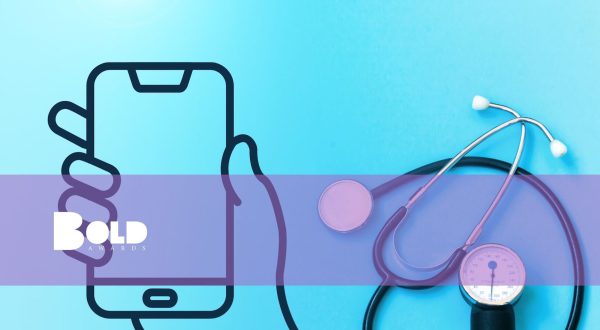The intersection of healthcare and technology has given rise to the dynamic field of healthtech. From artificial intelligence (AI) to telemedicine, wearable devices, and blockchain solutions, healthtech is revolutionizing the way we access, manage, and receive healthcare services. In this BOLD Awards blog, we will discover how healthtech trends in the form of AI, telemedicine, wearable devices, and more, are revolutionizing healthcare, provide healthtech examples, and learn what’s on the horizon for this dynamic industry.
1. Telemedicine and Virtual Healthcare
COVID-19, with its lockdowns and social distancing, accelerated the adoption and acceptance of telemedicine and virtual healthcare services among patients and clinicians alike. Patients can now connect with healthcare providers from the comfort of their homes using video consultations and remote monitoring devices.
Healthtech examples include UK speech therapy company BeneTalk. It provides a digital on-demand therapy solution to support people who stutter by acting like a fitness tracker that encourages the regular practice of speech and provides progress updates. It is used in some regions of the NHS (National Health Service), though end-users can make their own decisions to access virtual healthcare without having to first go through a doctor or medical consultant for approval or permission.
Expect telemedicine and virtual healthcare to continue to grow and become more sophisticated. The global telemedicine market size was valued at $87.41 billion in 2022, and is projected to grow from $94.44 billion in 2023 to $286.22 billion by 2030. Enhanced features like AI-driven diagnostics, real-time data sharing, and improved patient-doctor communication are healthtech trends that will redefine how we access healthcare.
2. Artificial Intelligence in Healthcare
AI is revolutionizing healthcare by enabling quicker and more accurate diagnosis, drug discovery, and treatment recommendations. Machine learning algorithms are sifting through vast datasets to identify patterns and predict disease outcomes.
AI will play an even more prominent role in personalized medicine, drug development, and healthcare management. In September 2023, Google announced new artificial intelligence-powered search capabilities that will help clinicians quickly access information from different data sources. The new features will be offered to health and life sciences organizations through Google’s Vertex AI Search platform. It will help save health-care workers’ valuable time and energy.
We can also expect AI-powered virtual health assistants to become commonplace, as they are in retail and banking, for example. In the healthcare sector they help patients monitor their health and adherence to treatment plans, and also hold conversations to reduce loneliness and anxiety. AI healthtech examples include Cecilia, the first virtual medical assistant developed with artificial intelligence (AI) in Chile. “Cecilia is not intended to replace consultation with a healthcare professional, but is one of the tools we have developed to guide and accompany our patients at all times.”
3. Wearable Health Devices
Wearable technology, such as fitness trackers and smartwatches, has evolved into sophisticated health monitoring devices. These wearables can track vital signs, sleep patterns, and even detect irregular heart rhythms. They can also provide medication reminders and store patient health information.
Wearables will become more integrated into our daily lives and healthcare systems. Powerful driving forces are advancements in sensor technology and the ability to make sensors and batteries very small. Wearables will offer advanced health tracking capabilities, early disease detection, and seamless integration with electronic health records.

Wearable technology can also overcome certain medical practices that some patients, or people who may be with them, can find off-putting. For example, the Freestyle Libre 2 is an advanced blood glucose reading device for diabetic glucose monitoring. A device placed on the upper arm uses a phone sensor to measure its reading, ending the need for patients to “prick” their fingers and draw blood.
Wearable healthtech examples include a new smart-ring that is currently available through crowdfunding. The device is an all-round fitness and wellness tracker that monitors heart rate, heart rate variability, step count and calories burned. When users are asleep, it tracks sleep patterns through blood oxygen level, skin temperature and resting heart rate measurement to provide a calculated sleep score. Results are viewable on a smartphone app, which also provides guided meditation and breathing exercises.
Easy access to such devices is one of the healthtech trends that encourage and enable people to take better care of themselves without requiring formal medical consultation.
4. Blockchain for Healthcare
In recent years, the healthcare industry has witnessed a surge in digital transformation efforts aimed at improving patient care and data. Blockchain technology is improving the security and interoperability of healthcare data. Patients have greater control over their medical records, and healthcare providers can access a patient’s history with ease.
Blockchain will play a pivotal role in healthcare data management and security. It will facilitate secure sharing of medical records among different providers, improving the continuity of care. Estonia-based technology company Medifakt is a healthtech example using a combination of blockchain technology, the Internet of Things (IoT), and Machine Learning (ML) to securely manage and share medical information and data from multiple sources.
5. 3D Printing in Medicine
3D printing technology is transforming healthcare by allowing for the creation of custom implants, prosthetics, and even human tissues. 3D printing produces made-to-measure implants that perform better, match better and last longer, for knees, spine, skull or hips.
This technology is revolutionizing surgical procedures and patient-specific treatments. Even small things like customized 3D-printing of surgical instruments with bespoke handles for scalpels, forceps or clamps help surgery staff perform better in the operating room, reducing operating time and contributing to improved patient outcomes.

Around 70% of premature babies require respiratory support. Non-invasive ventilation techniques deliver air to a connected mask through a tube. These masks, however, are not ideal for babies because their faces are smaller and shaped differently than those of adults. Also, due to the rapid growth of infants, they need new masks on a regular basis. 3D printing means infant masks can be customized and regularly reprinted.
The global market for 3D printing in healthcare was valued at $1,037 million in 2020, and is expected to reach $5,847 million by 2030, according to forecasts by Allied Market Research. We expect 3D printing to expand further into regenerative medicine, tissue engineering, and the production of medical devices. Customization and precision in healthcare will increase.
6. Genomic Medicine and CRISPR
Genomic medicine is advancing rapidly, thanks to technologies like CRISPR-Cas9, which enable precise gene editing, also called genome editing. The rapid development of genome editing technology has brought major breakthroughs in the fields of life science and medicine. These innovations hold the potential to cure genetic diseases and unlock new treatments.
CRISPR-Cas9 was adapted from a naturally occurring genome editing system that bacteria use as an immune defense. When they are infected with viruses, bacteria capture small pieces of the viruses’ DNA and insert them into their own DNA. They are inserted in a particular pattern that creates segments known as CRISPR arrays (Clustered Regularly Interspaced Short Palindromic Repeats). CRISPR arrays allow bacteria to recognise the viruses (or closely related ones) if they attack again. The bacteria then produce RNA segments from the CRISPR arrays and use Cas9, or a similar enzyme, to disable the virus.
Genomic medicine will continue to grow, offering personalized treatments based on an individual’s genetic makeup. Although the application of CRISPR-Cas9 in Alzheimer’s research is still in its infancy, researchers around the world are studying how gene editing could identify early signs of dementia, and then treat and ultimately prevent it. Traditional drug treatments offer only symptomatic relief. Scientists unveiled two new CRISPR-based therapeutic approaches to treat and prevent Alzheimer’s at the Alzheimer’s Association International Conference (AAIC) 2023 in Amsterdam.
Ethical considerations and regulatory frameworks will also evolve.
Conclusion
Healthtech examples such as these confirm technology is at the forefront of healthcare innovation, and the possibilities are boundless. From telemedicine and AI-driven diagnostics to wearable health devices and genomics, the future of healthcare promises more personalized, accessible, and effective solutions. As we embrace these healthtech trends and innovations, it’s essential to prioritize patient privacy, data security, and ethical considerations in the development and implementation of healthtech solutions. The healthcare landscape is evolving, and healthtech is at the helm of this transformation, promising a healthier and more connected future for all.
Be at the BOLD Awards Gala Dinner Ceremony
 Entries have closed and the finalists have been shortlisted for the 2024 BOLD Awards. Applications are open for you to request an invitation to attend the award ceremony on March 22nd, 2024, in Venice, Italy. It is a truly unique networking opportunity to meet international award winners and finalists in 33 categories of digital industries and the technology that powers them. Further details and how to apply are at https://bold-awards.com/request-an-invitation-for-bold-v/ #beBOLD
Entries have closed and the finalists have been shortlisted for the 2024 BOLD Awards. Applications are open for you to request an invitation to attend the award ceremony on March 22nd, 2024, in Venice, Italy. It is a truly unique networking opportunity to meet international award winners and finalists in 33 categories of digital industries and the technology that powers them. Further details and how to apply are at https://bold-awards.com/request-an-invitation-for-bold-v/ #beBOLD






